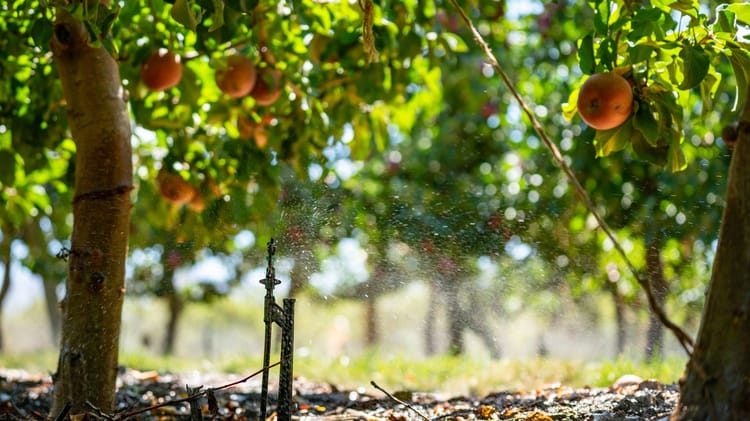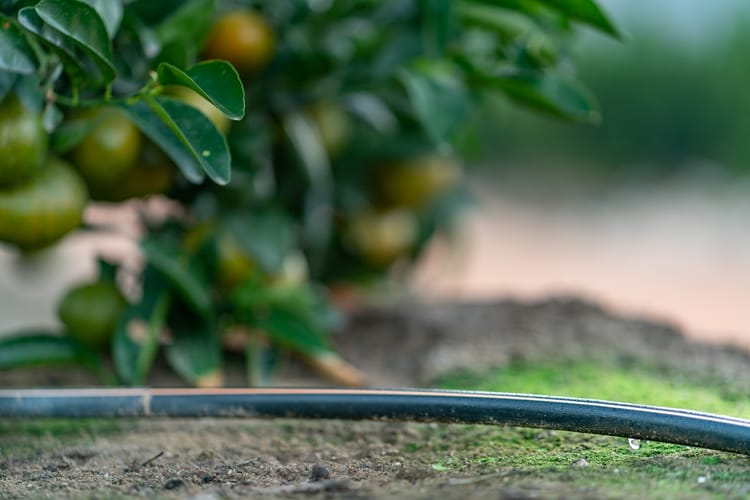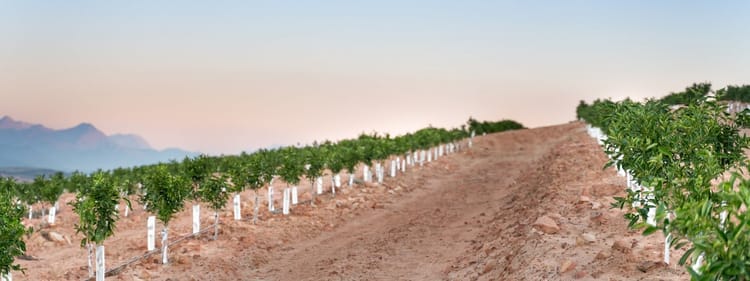Precision planning for precision irrigation
Precision irrigation requires an irrigation system that is designed and installed with all resources and production goals in mind, with the aim of ensuring optimal production.
Precision farming practices are becoming more of a necessity every day. This includes precision irrigation.
A lot of focus is placed on measurement and scheduling once the irrigation system has been installed, in order to ensure accurate irrigation.
So what exactly is precision irrigation?
This is a necessity considering the definition of precision irrigation: Precision irrigation is to deliver the correct amount of food and water to the plant at the correct time and in the right place.
A second part of the definition however reminds of another important aspect of precision irrigation. Precision irrigation is to deliver the correct amount of food and water to the plant uniformly distributed at the correct time and in the right place considering the smallest differentiable irrigation unit according to the needs of the resources involved.
Climate, soil and leaf moisture and other variables are, of course, continuously measured to ensure that scheduling can be adjusted to these needs in real time. This part of the definition however also places focus on the fact that thorough planning and preparation is required for successful precision irrigation.
Variable decisions
“When you develop a new farming project or, for example, a new orchard or vineyard, a host of questions must be answered, and a team of experts must be involved in the process. Irrigation planning is but one aspect of this. Importantly, irrigation planning will be based on data from all of the other analysis done and decisions made throughout the planning process,” explains Chris Malan, agronomy manager at Netafim South Africa.
Chris emphasises that a long list of variables must be measured, considered and analysed. “This must be done by the farmer, crop expert, soil expert, meteorologist, fertiliser expert, irrigation expert and any other necessary expertise.”
The variables are:
- Climate.
- Soil type (physical and chemical attributes).
- Water composition and availability.
- Topography.
- Availability of electricity.
- Diseases and pests.
Based on these variables, decisions are made on:
- Crops and/or cultivar.
- Soil preparation actions.
- Fertiliser requirements.
- Row direction, block design, roads.
- Plant spacing, row lengths, block sizes etc.
Now all that remains is deciding on the irrigation method, irrigation design and scheduling. Considering modern development with centralised control, decisions regarding block sizes are becoming the basis of water and nutrition management.
Farmers must rely on experts during the planning and preparation process.
“A properly designed and planned irrigation system that is managed correctly, will accommodate all of the variables mentioned above and will therefore ensure total control of water and nutrition levels.”
According to Chris, there is no one-size-fits-all solution in irrigation. That is why proper planning is so crucial. “There is no perfect irrigation system. You have to consider all of the advantages and disadvantages of a system and make a decision based on the circumstances of your farm, given all the variables.”
The perfect system
The final decision regarding the type of irrigation system you will use, will be determined by your experience and knowledge and prioritised irrigation goals.
After having considered the agronomic variables to decide on possible irrigation systems, the farmer has to consider another list of variables when choosing a system:
- Capital and running costs of the system.
- The farmer’s knowledge of and familiarity with the system.
- The management and maintenance ease of the system and the team’s ability to adhere.
- The reliability of the system considering your circumstances.
- The necessary capacity in terms of nutrition management and scheduling.
- The occurrence of wind, weeds etc.
- Installation requirements – especially in terms of labour and equipment.
- Possibility of theft.
Precision irrigation can be successfully performed through both drip irrigation systems and micro-sprinkler systems. The first and most important decision is to choose between these two systems.

Micro-irrigation systems
Irrigation with micro sprinklers allows for both full-surface irrigation and localised irrigation. An advantage of micro-sprinkler irrigation compared to drip irrigation is that a larger soil volume can be wetted. This makes irrigation management easier. Another advantage is that emitter blockages are more visible. Micro sprinklers are 85% efficient in applying water.
A few disadvantages of micro-sprinkler irrigation systems include higher evaporation losses during water application and from the soil surface, not being able to work in the orchard during active irrigation, and higher maintenance costs due to possible damage caused by workers in the orchards. Other disadvantages are fertiliser wastage due to less efficient application and water not being delivered to the root zone and falling onto leaves.

Drip irrigation systems
The most important advantage of drip irrigation compared to micro-sprinkler irrigation is that water use efficiency is much higher. Drip irrigation is 95% efficient in applying water and water is delivered directly to the root zone. Drip irrigation further makes it possible to apply fertiliser via the irrigation system, thus ensuring much higher efficiency during fertiliser application.
Other advantages include limiting evaporation losses during water delivery and from the soil surface, more efficient fertiliser application, improved weed management, the ability to irrigate with high EC and chloridic water and performing efficient pulse irrigation. The fact that there are no moving parts also requires less maintenance, saving on labour and maintenance costs. It is also possible to work in the orchard during active irrigation.
Disadvantages of drip irrigation compared to micro-sprinkler irrigation are that the emitter can clog more easily, blockages aren’t always visible and that finer, and therefore more expensive, filtration is necessary. Another challenge is that the system must be very well managed. It may also happen that, in poor soil, the distribution of water is not as desired.
Emitter choice
Once you have chosen between a drip or micro-sprinkler irrigation system, a long list of choices also has to be made regarding the configuration of the system.
In the case of micro-sprinkler irrigation, the two most important decisions are sprinkler selection and irrigation scheduling.
Chris explains that a manageable soil volume (40 to 60%) that does not have to be refilled daily, must be wetted – more frequent refilling leads to higher evaporation losses. The infiltration rate of the soil must not be exceeded. Your choice of micro-sprinkler will be determined by crop requirements, planting density, irrigation goals, soil type and soil preparation choices.
When it comes to drip irrigation, the most important considerations are crop water requirements, the required wetted area, application rate, working hours, the type of dripper and dripper delivery rate, dripper spacing and irrigation scheduling.
The choice of dripper will be determined by topography (whether a pressure compensated dripper is required), the number of growing seasons and water quality.
To make the right decision regarding dripper spacing, you have to understand the following concepts:
- Water moves differently in different soil types.
- Every soil has its own width and depth distribution.
- A longer irrigation time means wider and deeper water distribution.
Soil water distribution test
In subsequent articles on www.agriorbit.com, Netafim South Africa will also discuss irrigation scheduling, system maintenance and many other relevant topics.
It is, however, important to discuss one aspect of irrigation scheduling during the planning and preparation conversation. Robbie Childs, Netafim agronomist in KwaZulu-Natal, reminds us that it is important to know when to irrigate, how much water to apply and when not to irrigate. “If we do not possess this important knowledge, we run the risk of over- or under-irrigating.”
Tools and process
To collect the information above, we have to perform certain measurements, tests and calculations. “The final goal is to develop a scheduling plan that is user friendly, ensures sustainable production and delivers uniform results.”
One of the important tests that must be done during planning, is the simple soil water distribution test. This determines the width-to-depth wetting ratio of the soil. “Other data provides information as to how deep we must irrigate. After this test we will also know how wide the distribution of the water will be. This knowledge, combined with our knowledge of the soil’s water holding capacity, tells us the size of the soil reservoir.
For the simple soil water distribution test you will need a five- to ten-litre bucket and place it on a platform 40cm above the soil surface. Connect a dripper with a similar flow rate to the drippers used in the system, to a thin pipe. Connect the pipe to the bottom of the bucket and let the water flow onto the soil. Let the bucket run empty. You can then open a profile pit and look at the water distribution pattern.
Decide with an expert at your side
Chris reminds farmers of the importance of relying on experts during the planning and preparation process. Outside of what is discussed in this article, there are a host of other decisions to be made regarding filtration, nutrigation equipment and more. Netafim will discuss this in subsequent articles.


Share your thoughts
Comments
We'd love to hear your thoughts! To enter a comment, type your name and email address.